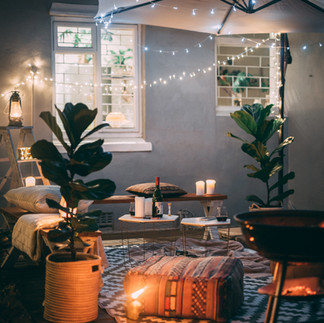Creating an Outdoor Living Space for Every Season
- Copia Real Estate
- Jul 18, 2023
- 3 min read
As homeowners, we all dream of having an outdoor living space that we can enjoy throughout the year, whether it's to entertain guests, relax after a stressful day, or simply spend time with family. While we all have different preferences, there are certain design elements that every outdoor living space should have in order to serve us during every season of the year. In this blog post, we will give you some useful tips and ideas on how to design an outdoor living space that is functional, inviting, and adaptable to any weather condition.

Pick the Right Location
Before you start designing your outdoor living space, you need to carefully choose the location that will work best for you and your family. Consider the amount of sun exposure, wind direction, and proximity to your house. If you want to use your outdoor space during the cooler months, it's a good idea to choose a location that is protected from the wind and has plenty of sun exposure. You could also consider adding a retractable awning or roof to your space to provide protection from the elements.

Incorporate Durable Materials
Your outdoor living space should be built to last, which means you need to choose durable materials that can withstand harsh weather conditions. Opt for materials such as concrete, stone, or composite decking that can handle extreme temperatures, moisture, and UV rays. Make sure your outdoor furniture is made from materials that are weather-resistant, such as resin wicker, wrought iron, or aluminum, and that your cushions are made from outdoor-grade fabrics that won't fade or mildew.

Install a Heat Source
If you're planning to use your outdoor living space during the colder months, especially in New England, installing a heat source is a must. There are many options to choose from, including gas heaters, fire pits, and chimineas. If you want something more environmentally friendly, you could opt for a wood-burning stove or a solar-powered heating system. Whatever option you choose, make sure it's safe and easy to use.

Add Greenery and Lighting
To make your outdoor living space more inviting, add some greenery and lighting. Plants not only provide a natural aesthetic but can also purify the air and help regulate temperature. Choose plants that are suitable for the climate in your area and require minimal maintenance. If gardening is not your thing, there are many low-maintenance and hardy perennial options that will add color and greenery to your space even in the cooler months.
As for lighting, consider installing LED bulbs that are energy-efficient and long-lasting. You could also add some string lights or lanterns for a cozy ambiance. Solar-powered lighting fixtures are a great option to add lighting features without raising your utility bills!
Create Zones for Different Activities
To maximize the functionality of your outdoor living space, create separate zones for different activities. For example, you could have a dining area, a lounge area, and a play area for kids. This will help you make the most of your space and accommodate different needs. You could also consider adding some built-in features such as a bar, a grill, or a water feature to enhance the functionality and appeal of your outdoor space.

Designing an outdoor living space that can serve you every season of the year requires careful planning and consideration of various factors such as location, materials, heating, lighting, and zoning. By following the tips and ideas mentioned above, you can create a functional, inviting, and adaptable space that will provide you with endless enjoyment throughout the year. So go ahead, start designing your dream outdoor living space, and enjoy the beauty of nature right in your backyard!








Comentarios